-
ORIGINAL ARTICLE08-07-2023
Factors associated with the time to treat breast cancer in the pandemic period: an observational study
Revista Brasileira de Enfermagem. 2023;76:e20220428
Abstract
ORIGINAL ARTICLEFactors associated with the time to treat breast cancer in the pandemic period: an observational study
Revista Brasileira de Enfermagem. 2023;76:e20220428
DOI 10.1590/0034-7167-2022-0428
Views0See moreABSTRACT
Objectives:
to analyze the factors associated with the time to surgical treatment for breast cancer in patients seen at a reference mastology outpatient clinic in the State of Ceará.
Methods:
analytical, longitudinal study with medical charts from the Mastology Outpatient Clinic of Assis Chateaubriand Maternity School. We used 140 medical charts of breast cancer patients with surgeries performed during the pandemic.
Results:
the study evidenced associations between schooling and shorter time to treatment in patients who underwent biopsy before the first outpatient visit (p = 0.026; OR: 0.16; CI = 0.03-0.85); in the group who had the biopsy performed by the outpatient clinic, was associated the type of tumor (p = 0.019) and neoadjuvant therapy (p = 0.000).
Conclusions:
the lesser educational level, tumor type, and use of neoadjuvant therapy were factors associated with the time to treatment during the pandemic period.
-
ORIGINAL ARTICLE08-07-2023
Nursing students’ knowledge and attitude in relation to COVID-19 prevention behavior
Revista Brasileira de Enfermagem. 2023;76:e20220588
Abstract
ORIGINAL ARTICLENursing students’ knowledge and attitude in relation to COVID-19 prevention behavior
Revista Brasileira de Enfermagem. 2023;76:e20220588
DOI 10.1590/0034-7167-2022-0588
Views0See moreABSTRACT
Objectives:
to determine the correlation between nursing students’ level of knowledge and attitudes toward COVID-19 prevention behavior.
Methods:
a cross-sectional study was carried out at the Private University in Indonesia. Accidental sampling was used to select 188 third-year bachelor’s nursing students as respondents. Data collection was conducted through an online questionnaire (Cronbach’s Alpha 0.799-0.959) consisting of 27 questions. The data were analyzed descriptively and inferentially.
Results:
as many as 49.5 % of respondents had high knowledge, 98.4 % had a positive attitude, and 89.9 % had positive behavior in preventing COVID-19 transmission. The Chi-square test revealed that knowledge has no correlation with COVID-19 prevention behavior (p-value 0.864), but attitude did (p-value 0.027).
Conclusions:
nursing students’ attitudes are related to behavior in preventing COVID-19. Nursing students are expected to maintain positive attitudes and behaviors toward COVID-19 prevention as future health workers at the forefront of health services.
-
08-07-2023
Conhecimento e atitude dos estudantes de enfermagem em relação ao comportamento de prevenção à COVID-19
Revista Brasileira de Enfermagem. 2023;76:e20220588
Abstract
Conhecimento e atitude dos estudantes de enfermagem em relação ao comportamento de prevenção à COVID-19
Revista Brasileira de Enfermagem. 2023;76:e20220588
DOI 10.1590/0034-7167-2022-0588
Views0See moreRESUMEN
Objetivos:
determinar la correlación entre el nivel de conocimiento y las actitudes de los estudiantes de enfermería en relación a la conducta de prevención de la COVID-19.
Métodos:
estudio transversal realizado en una Universidad Privada de Indonesia. Se utilizó un muestreo accidental para seleccionar a 188 estudiantes de tercer año de enfermería como encuestados. La recolección de datos se realizó mediante un cuestionario en línea que consta de 27 preguntas (alfa de Cronbach 0.799-0.959). Los datos fueron analizados de forma descriptiva e inferencial.
Resultados:
el 49,5 % de los encuestados tenía conocimientos altos, el 98,4 % tenía una actitud positiva y el 89,9 % tenía un comportamiento positivo en la prevención de la transmisión de la COVID-19. La prueba de Chi-cuadrado reveló que el conocimiento no tiene correlación con el comportamiento de prevención de COVID-19 (valor de p 0,864), pero la actitud sí (valor de p 0,027).
Conclusiones:
las actitudes de los estudiantes de enfermería están relacionadas con el comportamiento en la prevención del COVID-19. Se espera que los estudiantes de enfermería mantengan actitudes y comportamientos positivos hacia la prevención de COVID-19 como futuros profesionales de la salud en la primera línea de los servicios de salud.
-
08-07-2023
Senso de coerência e apoio social como preditores de saúde mental durante a pandemia de COVID-19
Revista Brasileira de Enfermagem. 2023;76:e20220468
Abstract
Senso de coerência e apoio social como preditores de saúde mental durante a pandemia de COVID-19
Revista Brasileira de Enfermagem. 2023;76:e20220468
DOI 10.1590/0034-7167-2022-0468
Views0See moreRESUMEN
Objetivos:
verificar el papel del sentido de coherencia, sentido de coherencia nacional, apoyo social y confianza en las instituciones como predictores de salud mental en brasileños durante la pandemia de COVID-19.
Métodos:
estudio transversal, realizado de noviembre de 2020 a enero de 2021 mediante cuestionario online. Se utilizaron instrumentos estandarizados. La muestra estuvo compuesta por 1.630 brasileños. En el análisis de datos se realizaron correlación de Pearson y regresión lineal.
Resultados:
el sentido de coherencia fue el único predictor de ansiedad [β= -0,61;p<0,001], explicando el 38% de la variación de sus puntuaciones, mientras que el sentido de coherencia [β=0,52;p<0,001], sentido de coherencia nacional [β= 0,16;p<0,001] y apoyo social [β=0,15;p<0,001] fueron predictores de salud mental positiva y en conjunto explicaron el 51% de su variación.
Conclusiones:
los hallazgos sugieren que sentido de coherencia, sentido de coherencia nacional y el apoyo social representan importantes predictores de salud mental y que el fortalecimiento de estos recursos, podría potencialmente promover la salud mental de los brasileños.
-
ORIGINAL ARTICLE08-07-2023
Sense of coherence and social support as predictors of mental health during COVID-19 pandemic
Revista Brasileira de Enfermagem. 2023;76:e20220468
Abstract
ORIGINAL ARTICLESense of coherence and social support as predictors of mental health during COVID-19 pandemic
Revista Brasileira de Enfermagem. 2023;76:e20220468
DOI 10.1590/0034-7167-2022-0468
Views0See moreABSTRACT
Objectives:
to verify the role of sense of coherence, sense of national coherence, social support and trust in institutions to predict mental health in Brazilians during the COVID-19 pandemic.
Methods:
a cross-sectional study, carried out from November, 2020 to January, 2021 via an online survey. Standardized instruments were used. The sample consisted of 1,630 Brazilians. Pearson’s correlation and linear regression were performed in data analysis.
Results:
sense of coherence was the only predictor of anxiety [β= -0.61; p<0.001], explaining 38% of the variance in its scores, while sense of coherence [β= 0.52; p<0.001], sense of national coherence [β= 0.16; p<0.001], and social support [β= 0.15; p<0.001] predicted positive mental health and together explained 51% of its variance.
Conclusions:
the findings suggest that sense of coherence, sense of national coherence and social support represent important predictors for mental health and that strengthening these resources, could potentially promote Brazilians’ mental health.
-
ORIGINAL ARTICLE07-31-2023
Primary Health Care assessment in the COVID-19 pandemic from physicians’ and nurses’ perspective
Revista Brasileira de Enfermagem. 2023;76:e20220475
Abstract
ORIGINAL ARTICLEPrimary Health Care assessment in the COVID-19 pandemic from physicians’ and nurses’ perspective
Revista Brasileira de Enfermagem. 2023;76:e20220475
DOI 10.1590/0034-7167-2022-0475
Views0See moreABSTRACT
Objectives:
to assess the operationalization of Primary Health Care in the COVID-19 pandemic, according to Primary Care Assessment Tool: PCATool-Brasil attributes, from physicians’ and nurses’ perspective.
Methods:
a cross-sectional study, carried out with 99 physicians and nurses from Basic Health Units in a state in northeastern Brazil, with the aid of the adapted instrument PCATool-Brasil.
Results:
Essential Score was classified as high performance (6.6) and General Score as low performance (6.5). First Contact Access, Care Integration, and Community Guidance scores were <6.6. The best performances were attributed to the Longitudinality, Comprehensiveness and Family Guidance services (scores>6.6).
Conclusions:
the attributes of Primary Health Care, in general, showed values above or close to the cut-off point in the assessment. These data can support strategies for local and national managers to strengthen Primary Health Care in the COVID-19 pandemic and future public health emergencies.
-
07-31-2023
Breastfeeding prevalence in newborns of mothers with COVID-19: a systematic review
Revista Brasileira de Enfermagem. 2023;76:e20220173
Abstract
Breastfeeding prevalence in newborns of mothers with COVID-19: a systematic review
Revista Brasileira de Enfermagem. 2023;76:e20220173
DOI 10.1590/0034-7167-2022-0173
Views0See moreABSTRACT
Objectives:
to compare exclusive breastfeeding prevalence versus artificial feeding in newborns of mothers with COVID-19.
Methods:
a systematic review of prevalence, according to JBI. Searches in PubMed®, Embase, CINAHL, LILACS and Web of Science™ databases in August 2021. Cross-sectional, longitudinal or cohort studies were selected, without language and time limitations that showed breastfeeding prevalence or that allowed calculation.
Results:
fifteen articles published in 2020 and 2021, cohort (60%) or cross-sectional (40%) were analyzed. The average of exclusive breastfeeding in mothers with COVID-19 was 56.76% (CI=39.90–72.88), and artificial breastfeeding, 43.23% (CI = 30.99 – 55.88), without statistically significant differences.
Conclusions:
despite the recommendations for maintaining breastfeeding, there was a reduction worldwide, when compared to periods prior to the pandemic. With advances in science, these rates have improved, showing the impact of evidence on practices. As limitations, study sources are cited. It is recommended to carry out new studies. PROSPERO registration CRD42021234486.
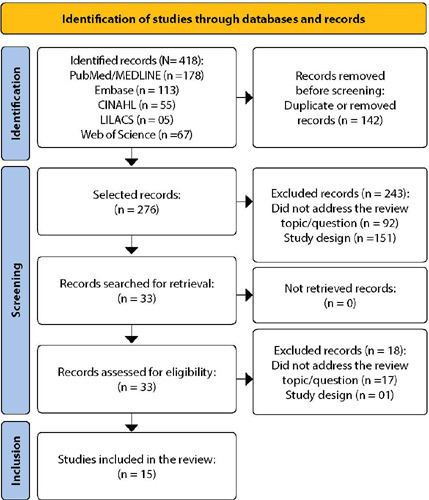
-
ORIGINAL ARTICLE07-31-2023
Sociodemographic profile, diagnoses and nursing care in post-COVID-19 patients in a Brazilian university hospital
Revista Brasileira de Enfermagem. 2023;76:e20220730
Abstract
ORIGINAL ARTICLESociodemographic profile, diagnoses and nursing care in post-COVID-19 patients in a Brazilian university hospital
Revista Brasileira de Enfermagem. 2023;76:e20220730
DOI 10.1590/0034-7167-2022-0730
Views0See moreABSTRACT
Objectives:
to analyze the sociodemographic profile, diagnoses and nursing care of post-COVID-19 patients admitted to a university hospital in southern Brazil.
Methods:
a retrospective cohort study. The sample consisted of 1,467 medical records, from January 2020 to January 2021.
Results:
from the analyzed medical records, the most prevalent profiles, respectively, included: males (52.9%); white (81.1%); with Impaired Physiological Balance Syndrome* Nursing Diagnosis (77.3%); nursing care implementing aerosol precautions (94.5%); implementing droplet precautions (93.4%); checking vital signs (91.9%); applying standard disinfectant to equipment and surfaces (89.6%).
Conclusions:
the analysis of the sociodemographic profile, diagnoses and nursing care of patients in this study may contribute to implementing the Nursing Process in the coronavirus pandemic context.

-
EXPERIENCE REPORT01-01-2018
Clinical and epidemiological teaching of dengue through simulated practice
Revista Brasileira de Enfermagem. 2018;71(2):451-456
Abstract
EXPERIENCE REPORTClinical and epidemiological teaching of dengue through simulated practice
Revista Brasileira de Enfermagem. 2018;71(2):451-456
DOI 10.1590/0034-7167-2016-0503
Views2See moreABSTRACT
Objective:
to describe the experience of clinical teaching on dengue and the practice of epidemiological surveillance using problematization methodology.
Method:
report of experience on educational activity with undergraduate nursing students, held in March 2016, at a public university in the city of São Paulo, conceived in four stages: dialogic lecture, active search of Aedes aegypti, case study and simulation of nursing consultation to individuals with dengue.
Results:
The activity allowed to retrieve previous knowledge about the disease, respond to exercises that addressed different clinical situations and epidemiological surveillance, including in situ evaluation of possible mosquito outbreaks, and discuss the need to expand prevention and health of the individual and the community, the impact of the media in the dissemination of cases and the coping difficulties experienced in the different levels of attention.
Conclusion:
the methodology adopted enabled qualified training of students to cope with dengue.

-
ORIGINAL ARTICLE07-18-2022
Beliefs, knowledge, actions of nursing techniques in breastfeeding in pain management in immunization
Revista Brasileira de Enfermagem. 2022;75(6):e20210546
Abstract
ORIGINAL ARTICLEBeliefs, knowledge, actions of nursing techniques in breastfeeding in pain management in immunization
Revista Brasileira de Enfermagem. 2022;75(6):e20210546
DOI 10.1590/0034-7167-2021-0546
Views1See moreABSTRACT
Objective:
Understand the beliefs, knowledge, and actions of nursing technicians on breastfeeding as a form of non-pharmacological intervention to relieve pain in newborns and infants during immunization.
Methods:
Qualitative study carried out through semi-structured interviews with nine nursing technicians from three Basic Health Units in a city in the state of São Paulo. The theoretical approach of the Belief Model and the methodological framework of Thematic Analysis supported this study.
Results:
Three themes originated: Beliefs, Knowledge, and Actions of nursing technicians.
Final considerations:
Despite knowledge about the benefits of breastfeeding as the most effective method for relieving pain in newborns and infants during vaccination, their restrictive beliefs overrode the evidence, leading them to act in ways that discourage or prevent the mother from breastfeed during vaccination. Formal training is recommended to align with current evidence-based practices.
-
REVIEW12-08-2023
Educational technologies for accident prevention due to falls in childhood: a scoping review
Revista Brasileira de Enfermagem. 2023;76:e20220807
Abstract
REVIEWEducational technologies for accident prevention due to falls in childhood: a scoping review
Revista Brasileira de Enfermagem. 2023;76:e20220807
DOI 10.1590/0034-7167-2022-0807
Views2See moreABSTRACT
Objectives:
to map evidence on educational technology use for accident prevention due to falls in childhood.
Methods:
a scoping review, carried out in October and November 2022, in the MEDLINE, Web of Science, BDENF and CINAHL databases and LILACS bibliographic index. There was no delimitation of language or time. Data were extracted and analyzed descriptively by two independent researchers. The research protocol was registered in the Open Science Framework.
Results:
twenty-six studies were selected. Booklets, pamphlets and leaflets were the most used technologies, presenting health services as the most frequent environment to develop research on fall prevention. The technologies developed were important outcomes: increased knowledge of children, family members, caregivers, health and education professionals.
Conclusions:
educational technology use makes it possible to increase knowledge, adopt safe practices and reduce falls.

-
REVIEW03-15-2024
Resources for health literacy among caregivers of prematurely born children: a scoping review
Revista Brasileira de Enfermagem. 2024;77(1):e20230062
Abstract
REVIEWResources for health literacy among caregivers of prematurely born children: a scoping review
Revista Brasileira de Enfermagem. 2024;77(1):e20230062
DOI 10.1590/0034-7167-2023-0062
Views1See moreABSTRACT
Objectives:
to map the available evidence on resources used to promote health literacy among caregivers of prematurely born children during outpatient follow-up.
Methods:
the Joanna Briggs Institute’s scope review protocol was utilized. The search encompassed six databases, incorporating studies from 2012 to 2022.
Results:
the three included publications revealed that the resources employed are: mobile applications, phone calls, individual counseling, videos, educational pamphlets, and group discussions. Implementing an education protocol during the transition home enhances scientifically grounded health promotion rates.
Conclusions:
there is limited literature addressing the health literacy of these caregivers. The nursing team plays a crucial role in health education and in developing resources applicable to these families.

-
ORIGINAL ARTICLE01-13-2024
Social representations of oncologic surgery for patients with cancer
Revista Brasileira de Enfermagem. 2024;77(6):e20230273
Abstract
ORIGINAL ARTICLESocial representations of oncologic surgery for patients with cancer
Revista Brasileira de Enfermagem. 2024;77(6):e20230273
DOI 10.1590/0034-7167-2023-0273
Views2See moreABSTRACT
Objectives:
to analyze the social representations of patients with cancer regarding oncologic surgery.
Methods:
a qualitative study based on Social Representation Theory was conducted with 126 participants between October 2021 and May 2022 in a public hospital in Rio de Janeiro. A characterization questionnaire, free evocations of the inducing term “surgery”, and semi-structured interviews with 60 participants were applied. Data were analyzed using Microsoft Excel® and IRaMuTeQ.
Results:
the central core of the representation is composed of fear, cure, hope, and removing the disease. The analysis of interviews resulted in six classes that highlight the social changes caused by treatment as well as the need for a support network to cope with the surgical process.
Final Considerations:
the representations reflect fear and hope towards the procedure and the desire to remove the disease, thus translating the cure through surgery.

-
ORIGINAL ARTICLE01-13-2024
Nurses’ perspectives on the use of telemonitoring in the management of people with diabetes and hypertension
Revista Brasileira de Enfermagem. 2024;77(6):e20230481
Abstract
ORIGINAL ARTICLENurses’ perspectives on the use of telemonitoring in the management of people with diabetes and hypertension
Revista Brasileira de Enfermagem. 2024;77(6):e20230481
DOI 10.1590/0034-7167-2023-0481
Views3See moreABSTRACT
Objectives:
to understand the perspective of nurses on the use of telemonitoring in the management of people with type 2 diabetes mellitus and arterial hypertension in primary care.
Methods:
this qualitative research involved sixteen nurses from eight municipalities in Paraná. Data were collected between November 2022 and January 2023 through inperson or remote interviews, which were audio-recorded and subjected to content analysis.
Results:
according to the nurses, telemonitoring enhances users’ knowledge about these conditions, communication and connection with the team, and productivity. However, the lack of electronic resources and equipment, high staff turnover, low user adherence, and the limited availability of professional time present significant challenges.
Final Considerations:
the effective implementation and operation of telemonitoring in the management of people with diabetes and hypertension involve both potential benefits and barriers. It is essential to have the availability of human and technological resources, managerial support, and the commitment of professionals and users.
-
ERRATUM01-13-2024
ERRATUM
Revista Brasileira de Enfermagem. 2024;77(6):e2024n6e08
Abstract
ERRATUMERRATUM
Revista Brasileira de Enfermagem. 2024;77(6):e2024n6e08
DOI 10.1590/0034-7167.20247706e08
Views2In the article “Brazilian nursing specific situation, middle and micro-range theories: a bibliometric study”, with DOI number: , published in Revista Brasileira de Enfermagem, 2024;77(4):e20230520, Chart 1:Where it read:[…]See more -
ORIGINAL ARTICLE09-29-2022
Palliative care production for health professionals in the context of home care
Revista Brasileira de Enfermagem. 2022;75(1):e20210030
Abstract
ORIGINAL ARTICLEPalliative care production for health professionals in the context of home care
Revista Brasileira de Enfermagem. 2022;75(1):e20210030
DOI 10.1590/0034-7167-2021-0030
Views1See moreABSTRACT
Objectives:
to analyze palliative care production developed by health professionals to home care patients.
Methods:
this is an exploratory study, with a qualitative approach, using the transpersonal care theoretical framework. Thirteen interviews were conducted with health professionals and 18 observations were conducted on different cases. Content analysis was performed using MAXQDA©.
Results:
actions performed: maintenance and follow-up measures to people eligible for palliative care, in acts of dialogue and “listening” to caregivers and users, conducting guidelines for the care and self-care process, performing technical procedures, delivery of materials, referrals and medical prescriptions to users.
Final Considerations:
it is perceived the need for advances in the implementation of government policies in Brazil that insert palliative care into the Health Care Network through educational, managerial and care actions that ensure human dignity, thus allowing the development of these and other palliative care interventions.
-
ORIGINAL ARTICLE07-08-2020
Nursing diagnosis Risk for Falls in the elderly in primary health care
Revista Brasileira de Enfermagem. 2020;73:e20180826
Abstract
ORIGINAL ARTICLENursing diagnosis Risk for Falls in the elderly in primary health care
Revista Brasileira de Enfermagem. 2020;73:e20180826
DOI 10.1590/0034-7167-2018-0826
Views0See moreABSTRACT
Objective:
to evaluate the Nursing Diagnosis (ND) Risk for Falls in elderly subjects in primary health care in the Federal District.
Methods:
a descriptive, quantitative, cross-sectional study conducted in two basic health units. Data collection included blood collection, nursing consultation and physical evaluation of 156 elderly subjects with chronic diseases.
Results:
the most prevalent intrinsic risk factors of NANDA-I were visual impairment (73.7%), impaired mobility (70.5%) and history of falls (69.9%); and extrinsic factors were the use of insufficient material in the bathroom (60.3%) and loose carpets (58.3%). The intrinsic factors that increased the risk for falls were the use of assistive devices (OR 3.50; p=0.030), impaired walking (OR 2.84; p=0.019) and cognitive impairment (OR 1.26; p=0.019); and the extrinsic factor was the use of loose rugs (OR 1.59; p=0.041).
Conclusion:
this ND has proved to be a valuable instrument for the identification of risk factors for falls in elderly subjects in primary care.
-
ORIGINAL ARTICLE07-13-2020
Predicting dimensions of clinical-functional conditions and cognition in the elderly
Revista Brasileira de Enfermagem. 2020;73:e20190162
Abstract
ORIGINAL ARTICLEPredicting dimensions of clinical-functional conditions and cognition in the elderly
Revista Brasileira de Enfermagem. 2020;73:e20190162
DOI 10.1590/0034-7167-2019-0162
Views0See moreABSTRACT
Objective:
To evaluate the predictive dimensions of clinical-functional conditions and the cognitive capacity of elderly people living at home.
Method:
Cross-sectional, population-based, analytical, quantitative study was utilized. For data collection, an instrument with sociodemographic and behavioral variables, the Functional Clinical Vulnerability Index; and, to assess cognition, the Mini-Mental State Examination (MMSE) was used. Descriptive analyzes and statistical tests were conducted.
Results:
305 elderly subjects, living at home, in urban and rural areas participated in the study. They were classified as robust (71.8%), pre-frail (22%) and frail (6.2%). As for cognition, 24.9% of them had cognitive impairment. It was shown that cognitive impairment predicts the development of functional disability.
Conclusion:
It is considered that health professionals should both act in order to maintain the functional and cognitive conditions of the robust and pre-frail elderly people and pay attention to the rehabilitation of the disabilities installed in those elderly people who are in a situation of frailty.
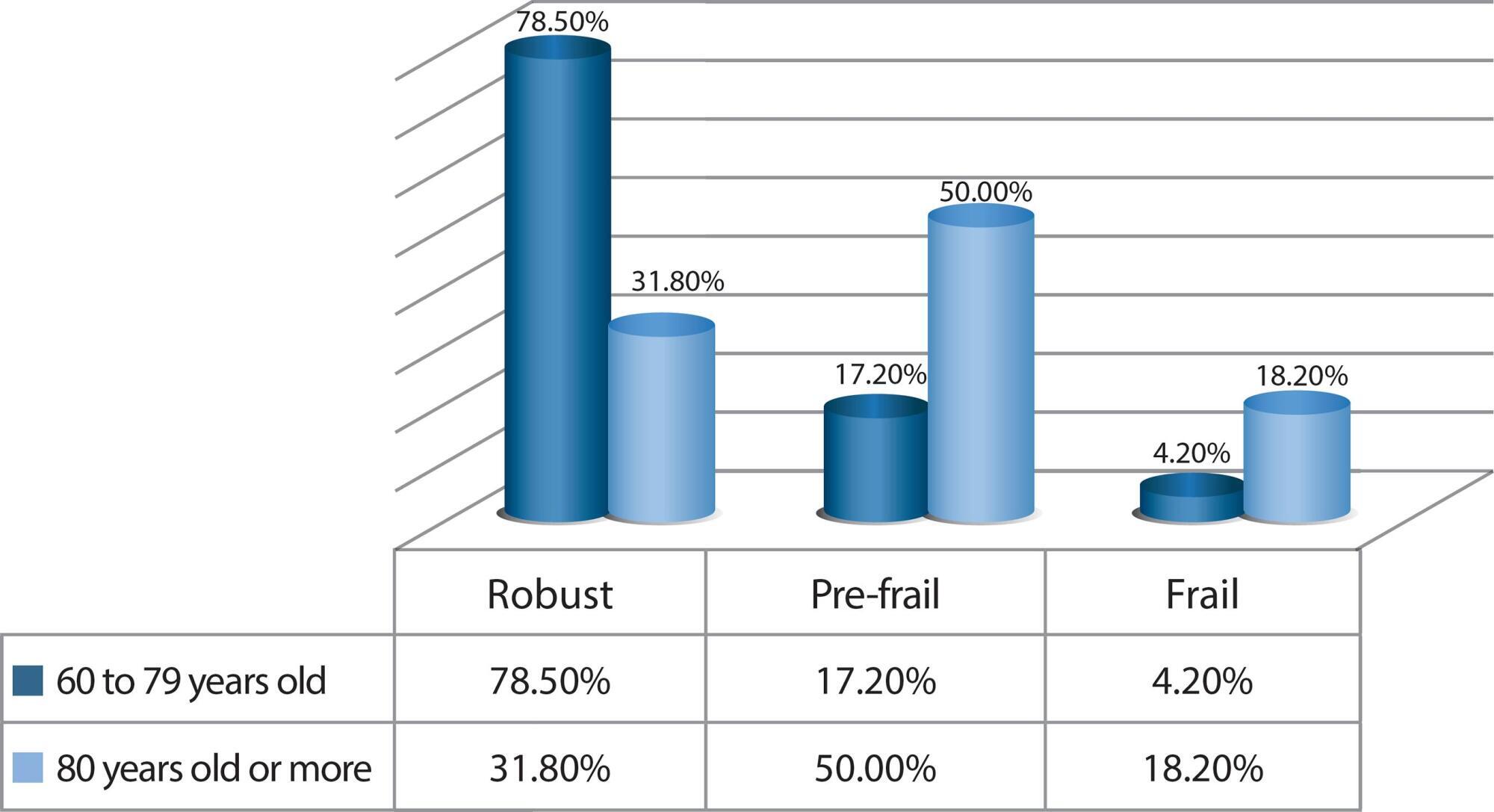
-
ORIGINAL ARTICLE07-31-2020
Educational demands of family members of children with special health care needs in the transition from hospital to home
Revista Brasileira de Enfermagem. 2020;73:e20190156
Abstract
ORIGINAL ARTICLEEducational demands of family members of children with special health care needs in the transition from hospital to home
Revista Brasileira de Enfermagem. 2020;73:e20190156
DOI 10.1590/0034-7167-2019-0156
Views0See moreABSTRACT
Objectives:
to analyze the educational demands of family members of children with special health care needs in the transition from hospital to home
Methods:
qualitative research conducted between February and June 2018, using the handbook on creativity and sensitivity dynamics, from the sensitive creative method; the participants were nine family caregivers of children admitted to a public hospital in Rio de Janeiro; the data were subjected to French discourse analysis
Results:
the educational demands were clinical, centered on the categories complex and continuous care, technological care, modified habits, medication, development and mixed care, and social, related to the supplies and rights of children
Final Considerations:
the social educational demand has emerged as a new demand to be incorporated in the care of these children. The transition from hospital to home should be progressive and have the nurse as its coordinator, with the objective of providing participatory, safe, quality care, articulated within a social network
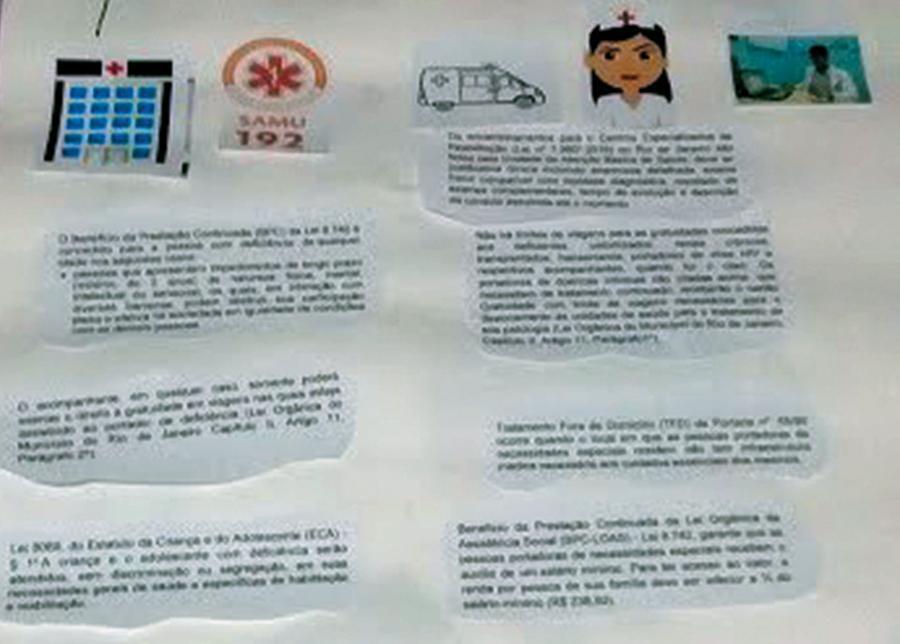
-
EXPERIENCE REPORT07-31-2020
(In)visibility of children with special health needs and their families in primary care
Revista Brasileira de Enfermagem. 2020;73:e20190071
Abstract
EXPERIENCE REPORT(In)visibility of children with special health needs and their families in primary care
Revista Brasileira de Enfermagem. 2020;73:e20190071
DOI 10.1590/0034-7167-2019-0071
Views0See moreABSTRACT
Objectives:
to discuss the (in)visibility of children with special healthcare needs and their families in the Primary Health Care scenario.
Methods:
experience report about the difficulties faced by researchers from different regions of Brazil to locate children with special healthcare needs in the scope of primary care.
Results:
the main reason for these children and their families to be “unknown” and, therefore, not assisted in PHC, is the fact that they are followed-up by institutions/outpatient clinics and specialized and/or public rehabilitation clinics, or even because they have private health insurance.
Final Considerations:
transferring care responsibility to the Primary Health Care teams to specialized and rehabilitation institutions may be related to the lack of knowledge of the care demands of this group, as well as to the relevance of care centered on rehabilitation and the specialty instead of the long-term care, one of the features of primary health care.
-
ORIGINAL ARTICLE07-15-2020
Influence of health care practices on the burden of caregiver mothers
Revista Brasileira de Enfermagem. 2020;73:e20190154
Abstract
ORIGINAL ARTICLEInfluence of health care practices on the burden of caregiver mothers
Revista Brasileira de Enfermagem. 2020;73:e20190154
DOI 10.1590/0034-7167-2019-0154
Views0See moreABSTRACT
Objectives:
to explore the influence of health care practices on the burden of caregiver mothers of children with special health needs.
Methods:
observational, analytical, cross-sectional, quantitative study. Participation of 100 caregiver mothers, who responded the following instruments: characterization instrument; Burden Interview for Informal Caregivers; Perceptions of Family-Centered Care – Parents version; Evaluation Instrument for Primary Care – Child Version. For statistical analysis, were used the Spearman’s Correlation and univariate and multivariate linear regression analysis.
Results:
the mean burden score was 47.99. There was a negative correlation between the burden and the domains of collaboration and support of the Perceptions of Family-Centered Care scale. In the multivariate linear regression model, the longitudinality variable maintained a significant relation with the burden (p = 0.023).
Conclusions:
a shared, longitudinal and integrated care between families and health services can ease the burden of caregiver mothers.
-
ORIGINAL ARTICLE08-20-2021
Resilience of family caregivers of children and adolescents in treatment of neoplasms and associated factors
Revista Brasileira de Enfermagem. 2021;74(6):e20190388
Abstract
ORIGINAL ARTICLEResilience of family caregivers of children and adolescents in treatment of neoplasms and associated factors
Revista Brasileira de Enfermagem. 2021;74(6):e20190388
DOI 10.1590/0034-7167-2019-0388
Views0See moreABSTRACT
Objectives:
analyze the level of resilience of family caregivers of children and adolescents hospitalized for cancer treatment and associated factors.
Methods:
cross-sectional study, carried out in 2018, with 62 family caregivers in a university hospital in the state of Rio Grande do Sul, Brazil. The instruments CDRisc-10-Br, SRQ20, PSS-14 and WHOQOL-Bref were used to measure resilience, minor psychological disorders, stress, and quality of life, respectively. Inferential statistics were used.
Results:
female caregivers, married, with one child and who practice some predominated religion. They were classified as having a moderate level of resilience (48.4%); with suspicion for minor psychological disorders (45%) and high level of stress (41%). In terms of quality of life, they were satisfied in the Physical, Psychological and Social Relations domains; and dissatisfied in the Environment domain.
Conclusions:
there were direct weak to moderate correlations between the level of resilience and quality of life and inversely with stress and minor psychological disorders.
-
ORIGINAL ARTICLE12-07-2020
Construction and validation of an educational gerontotechnology on frailty in elderly people
Revista Brasileira de Enfermagem. 2020;73:e20200800
Abstract
ORIGINAL ARTICLEConstruction and validation of an educational gerontotechnology on frailty in elderly people
Revista Brasileira de Enfermagem. 2020;73:e20200800
DOI 10.1590/0034-7167-2020-0800
Views0See moreABSTRACT
Objective:
to construct and validate an educational gerontechnology on frailty in elderly people.
Method:
a methodological study developed in three stages: educational video construction, validation by expert judges and elderly people. Validation was carried out by 22 judges and 22 elderly people. Educational Content Validation Instrument was used for judges and questions adapted from the Suitability Assessment of Materials questionnaire for elderly people. For validation, agreement criterion greater than 80% was considered, verified using Content Validation Index and binomial test.
Results:
the video addresses recommendations for elderly people at risk of frailty and health-promoting habits, using cordel literature. An agreement greater than 80% was verified in all items assessed by judges and the target audience.
Conclusion:
the video proved to be valid in terms of content and appearance by judges and elderly people, with the potential to mediate health-promoting educational practices in healthy aging.
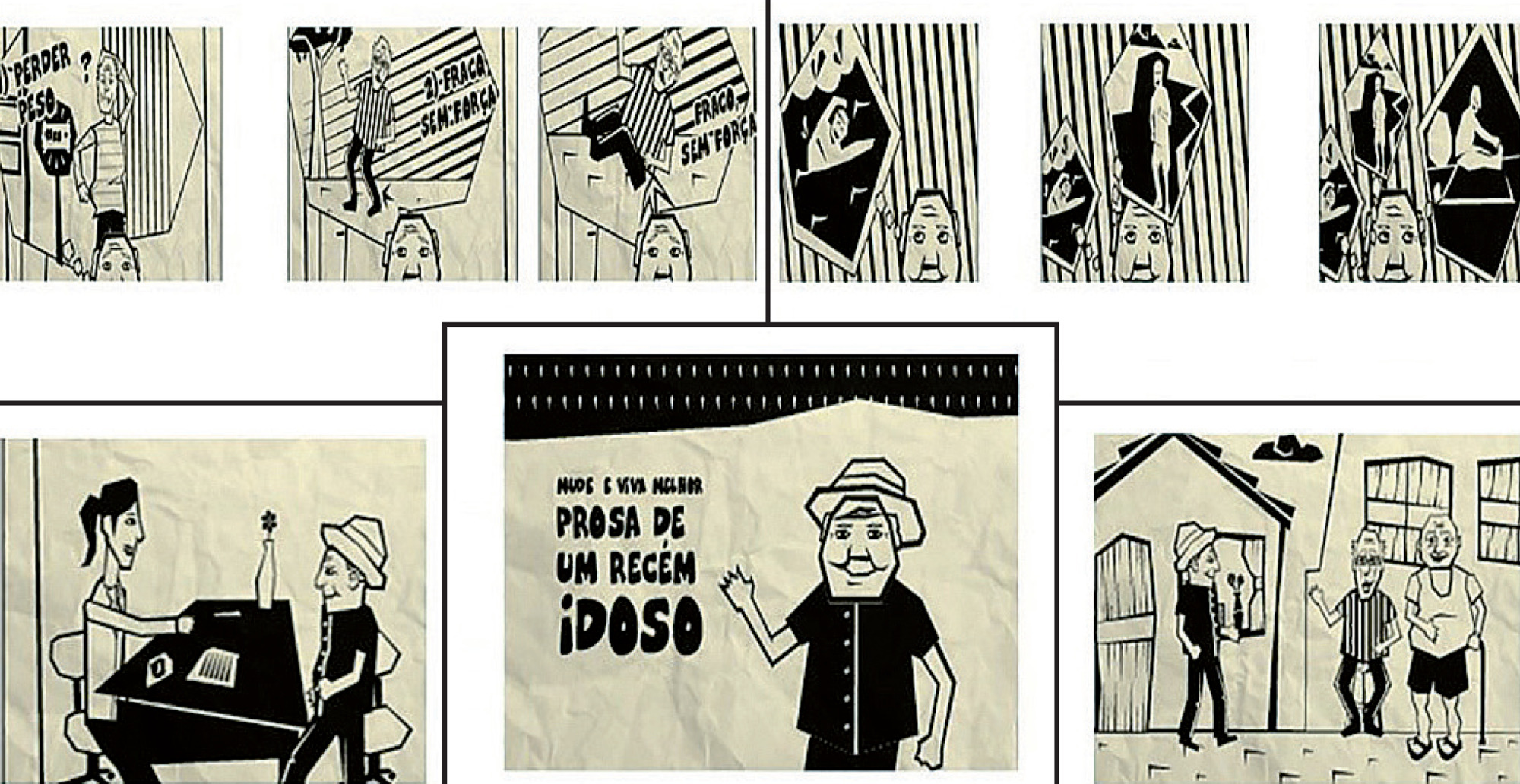
-
REVIEW07-09-2021
Nursing care for patients in post-transplantation of hematopoietic stem cells: an integrative review
Revista Brasileira de Enfermagem. 2021;74(3):e20200097
Abstract
REVIEWNursing care for patients in post-transplantation of hematopoietic stem cells: an integrative review
Revista Brasileira de Enfermagem. 2021;74(3):e20200097
DOI 10.1590/0034-7167-2020-0097
Views0See moreABSTRACT
Objectives:
to analyze the available evidence on the nursing care provided to patients after hematopoietic stem cell transplantation.
Methods:
integrative review with the search for primary studies in four databases and a virtual health library. A broad search strategy was used, including research published in English, Brazilian Portuguese, or Spanish, between 2008 and 2018, totaling a sample of 42 studies.
Results:
the studies were grouped into three categories: multiple nursing care (n=19), first-line care (n=18), and self-management of care (n=5).
Conclusions:
nursing care is critical, comprising patients’ physical, psychological and social aspects. It occurs in hospital and home contexts, mainly involving technical actions and health guidance. The evidence identified provide subsidies for decision-making; however, most studies are of the non-experimental type, indicating the need for conducting intervention research.
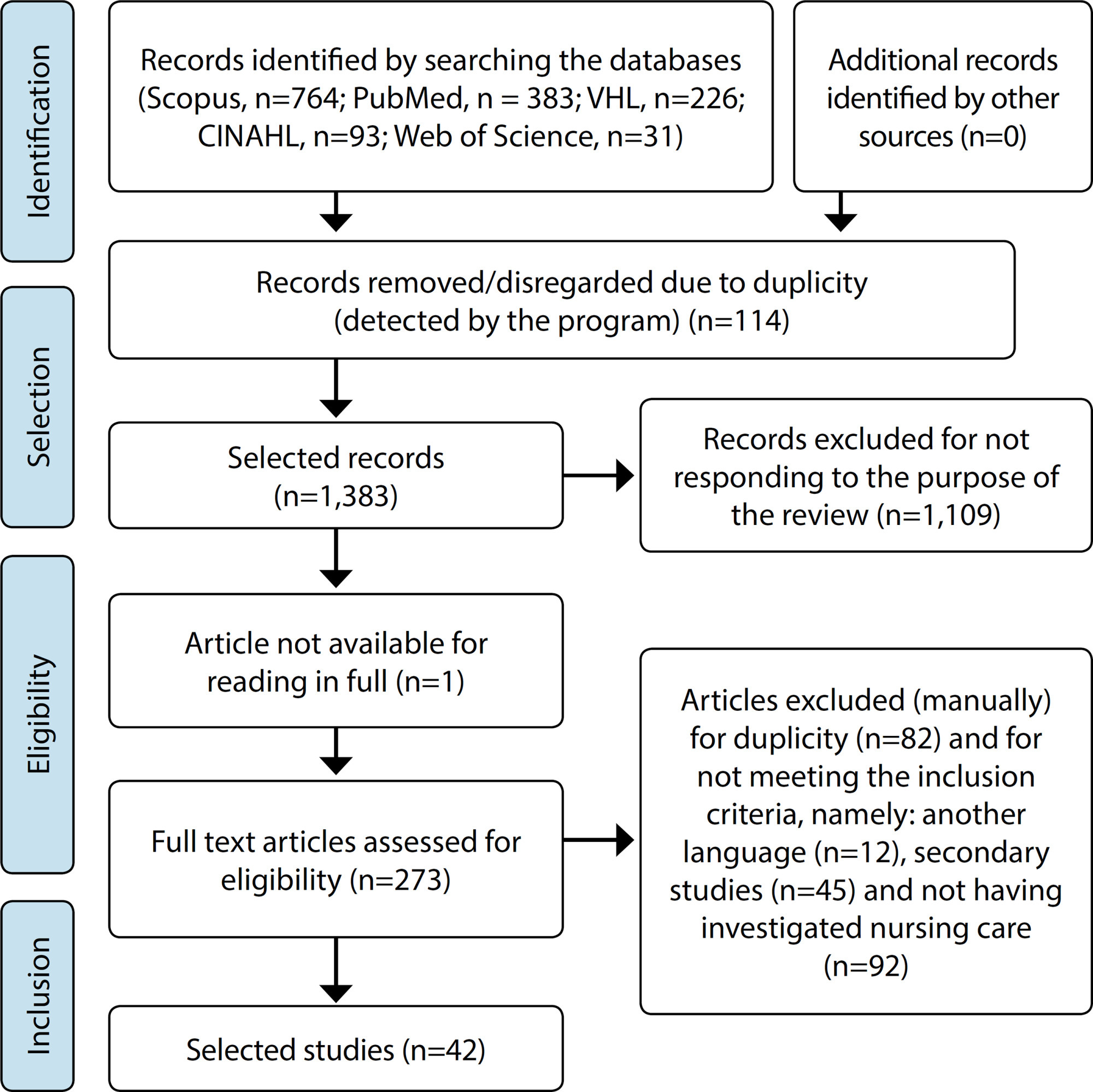
Search
Search in:
Nuvem de Tags
Adolescente (85) Atenção Primária à Saúde (239) COVID-19 (91) Criança (91) Cuidados de Enfermagem (269) Educação em Enfermagem (151) Educação em Saúde (139) Enfermagem (930) Enfermagem Pediátrica (86) Estudantes de Enfermagem (77) Estudos de Validação (131) Família (87) Idoso (208) Promoção da Saúde (99) Qualidade de Vida (104) Saúde do Trabalhador (86) Saúde Mental (145) Saúde Pública (82) Segurança do Paciente (150) Tecnologia Educacional (100)



